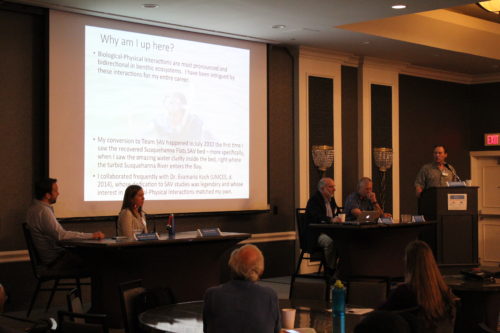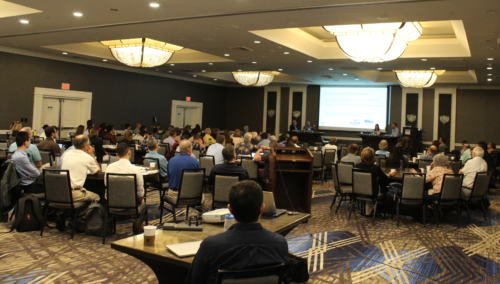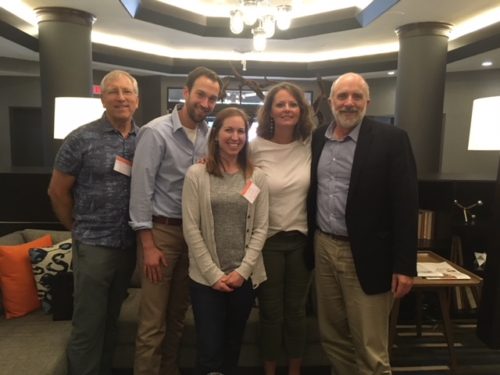Seagrass recovery in Chesapeake Bay: A success for Chesapeake Bay research and restoration
Bill Dennison ·Raleigh Hood asked Bob “JJ” Orth, Jon Lefcheck, Cassie Gurbisz and me to conduct a panel presentation and discussion at the 2018 Chesapeake Research and Modeling Symposium. This conference, sponsored by the Chesapeake Research Consortium, NOAA and the National Science Foundation, was held in Annapolis on 12-14 June 2018. Larry Sanford was the panel moderator and JJ, Jon, Cassie and I jointly presented the results of our Submerged Aquatic Vegetation synthesis (SAV SYN) team.

JJ and I provided the historical context for SAV in Chesapeake Bay. We highlighted the impact of the 1972 Hurricane Agnes, which almost derailed JJ’s dissertation research. We reviewed the description of the SAV decline in Chesapeake Bay1 and the identification of the key role of nutrients in the decline2. To combat the decline, scientists established the Chesapeake Bay Program, water quality monitoring program and aerial surveys of SAV in 1983-1984. We recounted the initial SAV synthesis3 in which SAV were identified as 'coastal canaries' and established habitat requirements for water quality using the ten years of available data. The habitat requirements were refined and expanded in a subsequent synthesis effort4.
We highlighted the approach we used for the Global Seagrass Trajectories working group, sponsored by the National Center for Ecological Analysis and Synthesis (NCEAS). In this effort, we coauthored a Bioscience paper5 at our initial meeting and then built a global database in subsequent meetings, resulting in a quantitative paper published in the Proceedings of the National Academy of Science6. In addition, we identified the lack of ‘coastal charisma’ by seagrasses, especially compared with salt marshes, mangroves and corals that receive more media attention7. We have attempted redress this imbalance, promoting seagrasses with videos Seagrass Blue Carbon Blues, and poems such as the Chesapeake Sentinels, for example.
JJ and I proposed a Chesapeake Synthesis Center in 2009, which was not funded. So we self-funded a SAV synthesis in 2010 to demonstrate how this could function. In this synthesis, we subdivided the Chesapeake SAV into different communities based on salinity regimes and analyzed for water quality drivers8. In 2016, Rich Batiuk from the Chesapeake Bay Program approached us to conduct a synthesis effort. We responded by hiring Jon Lefcheck as a VIMS postdoc and forming the SAV SYN team, which consists of Bill Dennison, Cassie Gurbisz, Mike Hannam, Jeni Keisman, Brooke Landry, Jon Lefcheck, Ken Moore, Rebecca Murphy, Bob Orth, Chris Patrick, Jeremy Testa, Don Weller and Dave Wilcox. These people were selected based on their scientific capabilities, their commitment to Chesapeake Bay, and their willingness to work collaboratively towards a common cause.
We distilled Rich’s wish list into two fundamental questions: 1) What are the long term trends SAV trends in Chesapeake Bay? and 2) How are the trends related to human activities? Modeled after our NCEAS experience, we initiated a Bioscience paper9 in our first meeting. In this paper, we articulated two different meanings of the word “sentinel” in relation to Chesapeake SAV. One meaning is indicator and the other is guardian, describing the important different roles that SAV have in Chesapeake Bay.

Jon Lefcheck provided an overview of a negative case study of the decline of eelgrass, Zostera marina, in Chesapeake Bay due to climate change10. Cassie Gurbisz provided a detailed description of a positive case study of the resurgence of multiple SAV species in the Susquehanna Flats at the head of Chesapeake Bay. Cassie highlighted the role of feedbacks, demonstrating that once SAV meadows become established, they can accelerate their own growth and expansion11,12. She then recounted the impact of Tropical Storm Lee in 2011, which threatened to derail her dissertation, not unlike what Hurricane Agnes did to JJ back in 1972. But Cassie, like JJ, turned this potential disaster into a research opportunity. She showed how turbidity due to Tropical Storm Lee resulted in an initial decline in the Susquehanna Flats SAV, but recovery was aided by the dampening of re-suspension of the fine-grained sediments delivered during the high flows13.

Following the case studies, Jon described structural equation modeling, linking the conceptual models we used in SAV SYN back to the original synthesis efforts described previously. The two independent approaches that we employed were a) sub-estuary analysis and b) Bay-wide analysis. In these analyses, we were able to conclude that nutrient reductions led to SAV resurgence in a paper published in the Proceedings of the National Academy of Science (PNAS)14.
We were able to answer the two original questions:
1) What are the long term SAV trends in Chesapeake Bay?
Nutrient reductions have led to SAV recovery since the 1980s.
2) How are the trends related to human activities?
Nutrient pollution reduces SAV and species enrichment enhances SAV.
We employed a large media push associated with publication of the PNAS paper, which included a visit to the National Press Club in Washington, D.C. This media push resulted in multiple media accounts and a couple of editorials in the Washington Post in which the SAV resurgence was seen as evidence that the Total Maximum Daily Load “nutrient diet” was working and that funding for the Chesapeake Bay Program should be continued. JJ and I were asked to write an article for The Conversation, which we found to be a totally positive experience. Excellent editing, good illustrations and rapid turnaround led to an article that was widely disseminated.
We described the segment analysis, still underway. Targeted for resource managers, 57 fact sheets are being created for each SAV segment. These fact sheets utilize a time course graphic of SAV density and a time course conceptual diagram highlighting the major impacts on various SAV communities. Melissa Merritt, a staffer from the Chesapeake Bay Program, was recruited for this effort. A stoplight color scheme was employed to identify the attainability of the SAV goal for each segment.
We reflected on the SAV SYN process and identified three enabling conditions: 1) a compelling topic, 2) resource managers (Rich Batiuk in this case) articulating the management relevant analyses and 3) nominal support, which also provided leveraging opportunities.
We also identified the importance of experienced leadership, limited size of the synthesis team, multiple immersive workshops, regular communication, flexibility in agendas and membership, a focus on products like peer review papers and fact sheets, conducive location, clear goals and objectives, and having fun along the way. In the future, we recommend using staffers and graduate students more, as well as the blend of experienced and young researchers. These synthesis lessons are described in more detail in previous blogs.
Our presentation was concluded with the presentation of “Chesapeake, Chesapeake,” a song inspired by our visit to the National Press Club described in a previous blog. The video was produced by Jamie Currie and Sky Swanson, featuring the amazing vocals by Melanie Jackson.

References:
About the author
Bill Dennison

Dr. Bill Dennison is a Professor of Marine Science and Vice President for Science Application at the University of Maryland Center for Environmental Science.

